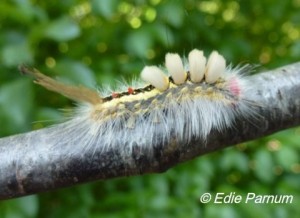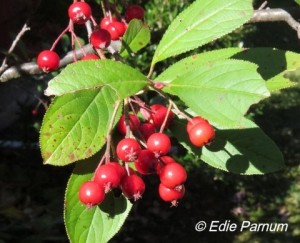By Edie Parnum
Oh, no, you say. I never make resolutions—too much self-denial and discipline.
Here are some resolutions that don’t require much work. And, in fact, they’ll add pleasure to your life. Pick one of these to get started. Birds, butterflies, and other creatures will visit your yard. Pick three, and you’ll see nature flourish abundantly–guaranteed.
- Plant a tree. Adding a native (historically part of our local ecosystem and food web) tree is the single best contribution you can make to your property’s habitat. It will offer more food, shelter, and nesting places than any other plant. Besides providing seeds, fruits, or nuts directly to birds and other animals, the tree’s leaves host native insects. Birds and other small animals eat native insects in
large quantities. The small animals are prey to larger ones. Thus, this native tree and its insects contribute enormously to fuel your yard’s ecosystem. It’s easy and inexpensive to plant a sapling tree. It will establish quickly, grow fast, and sustain wildlife for decades. Surely you have room for one tree (small or large), perhaps several of them. Native oaks offer the best wildlife value but check our website for other valuable native trees.
- Plant shrubs. Requiring less space than a tree, they offer nearly as much value to a healthy habitat. Besides the nutritious fruits these woody plants produce, insects eat their leaves. As with trees, these insects sustain birds and the other animals in the web of life. Also, dense deciduous and evergreen shrubs provide
cover and places for nesting birds. Highbush Blueberry (Vaccinium corymbosum), Red and Black Chokeberry (Aronia sp.), Northern Bayberry (Morella pensylvanica), and various native dogwoods (Cornus sp.) and viburnums (Viburnum sp.) are excellent choices. Plant three or more of each species. See our website for recommended shrubs.
- Plant perennials, not annuals. Annual flowers are so much trouble to put in each year, fertilize, and keep watered. Forget the bothersome begonias, impatiens, marigolds, coleus. petunias, and the like. Native perennials will grow
and bloom beautifully for years without any extra care. My favorites are Butterfly Weed (Asclepias tuberosa), Summer Phlox (Phlox paniculata), New England Aster (Symphyotrichum novae-angelae), Bee Balm (Monarda didyma), and Mountain Mint (Pycnanthemum muticum), but there are many other beautiful native perennials. All provide nectar and pollen for bees, butterflies, and other pollinators. Like other native plants, they host native insects, too.
- Plant a vine. If you want hummingbirds in your yard, plant a Trumpet Honeysuckle (Lonicera sempervirens) (not the invasive Japanese Honeysuckle, of course) or Trumpet Vine (Campsis radicans). Virgin’s Bower (Clematis virginiana) is a magnet for bees, moths, and other pollinators.
- Plant groundcovers. Minimize weeding. Instead, cover the ground with native groundcovers like Allegheny Pachysandra (Pachysandra procumbens), Green and Gold (Chrysogonum virginianum), and Golden Ragwort (Packera aurea).
- Take out a patch of lawn. It’s the most biologically deficient part of your yard—not much better than your driveway. Every year decrease the size of your lawn
and keep only what you use for family activities, dog play, and other outdoor activities. Instead of turf grass, plant any and all of the above: trees, shrubs, perennials, vines, groundcovers.
- Take out invasives. Invasive plants spread aggressively and crowd out desirable native vegetation. Yes, whether you cut, pull, or smother the invasives, it can be a lot of work. Plus, if you leave the ground bare afterward, of course they’ll come back. Immediately fill in the cleared area with native plants.
- Learn native plants. You can attend botany walks at Bowman’s Hill Wildflower Preserve, Heinz National Wildlife Refuge, and Tyler Arboretum. Visit a botanical preserve where native plants are labeled such as Bowman’s Hill and Jenkins Arboretum. When buying plants at native plant nurseries like Redbud Nursery and Yellow Springs Farm, you’ll see labelled plants and learn growing tips from their knowledgeable staffs. Use the internet photos and gardening information, too.
- Read a book. I recommend Bringing Nature Home: How You Can Sustain Wildlife with Native Plants. The author, Douglas Tallamy, professor and chair of the Department of Entomology and Wildlife Ecology at the University of Delaware, will inspire you to plant native plants and increase your determination to host native insects, birds, and butterflies in your yard.
- Walk around and enjoy nature in your yard frequently. Take your binoculars to better see and learn about the birds, butterflies, and other creatures that live in your garden. With a camera you can take photos of your plants and wildlife sightings. You’ll be inspired to become more familiar with your own wildlife preserve. Spread your enthusiasm: take a child with you on your backyard adventures.
Personally I will do all ten of these—with pleasure.
If you’re a beginner to habitat gardening, pick one of these ideas to get started. Perhaps you can tackle two or three this year, but don’t get overly ambitious. Start planning now in the dead of winter. Time and money may be limited, but you can start small and keep improving your habitat each year. Before long you’ll notice more insects including butterflies and moths, more birds, and, indeed, much more wildlife activity in your yard.
Do something for nature in 2014.






I, like you, refrain from making a list of resolutions but will refer to your list as I make my pledge to enhance the ecosystem of our yard. My pledge is to increase and add variety to the native plants, trees and shrubs in our yard. Thanks for the ideas.
Bonnie, I’m happy to hear about your pledge! You are sure to see more wildlife in your yard as a result. I hope others will join you and take the same pledge.
Edie
These are all great suggestions, but I have two caveats to add. First, many of the native shrubs that provide food and habitat to our native insects and birds are also favorites of my four-footed nemesis, the white-tailed deer. Northern bayberry, aronia, blueberry, viburnum, and cornus have all been decimated in my yard by deer. I cannot fence such a large area, and deer net is both cumbersome and dangerous to the birds. It’s very frustrating to have to restrict our choices because of these pesky browsers. I would also caution anyone planting trumpet vine (campsis radicans) to beware its tendency to spread via root runners, which in my experience can invade flower beds and lawns, and can be very hard to eradicate.
Susan, thanks for commenting. Here are my thoughts.
Trumpet Vine — Yes, this is an aggressive, albeit native vine. As you say, Susan, it spreads by underground runners. However, this vine has considerable wildlife value. The flowers are irresistible to hummingbirds, and its foliage is eaten by several species of moth caterpillars. Plant it where it can grow up a free-standing snag or large structure where it can be mowed regularly around the base.
White-tailed Deer — Of course deer like many native plants and are troublesome for habitat gardeners. Personally I encircle newly planted trees and shrubs with fencing. For perennials I use deer repellent with some success. Natives that are strong-tasting or thorny are less attractive to deer. Limiting deer damage on a a property with native plants will be a subject for a future blog.
Edie